The Irish defense and special teams served up the perfect chance for a relaxing afternoon against UNLV, but the offense struggled to throw down the alley oops enough that starters were still playing in the closing minutes. It was a fine but unsatisfying performance, as a hot start with two punt blocks and multiple 3-and-outs led to 5 scoring chances for the Irish in the first quarter alone. But the offense had just a 29% success rate during that frame, settling for field goals and leaving the game in an annoying, uncomfortable state for much of the contest.
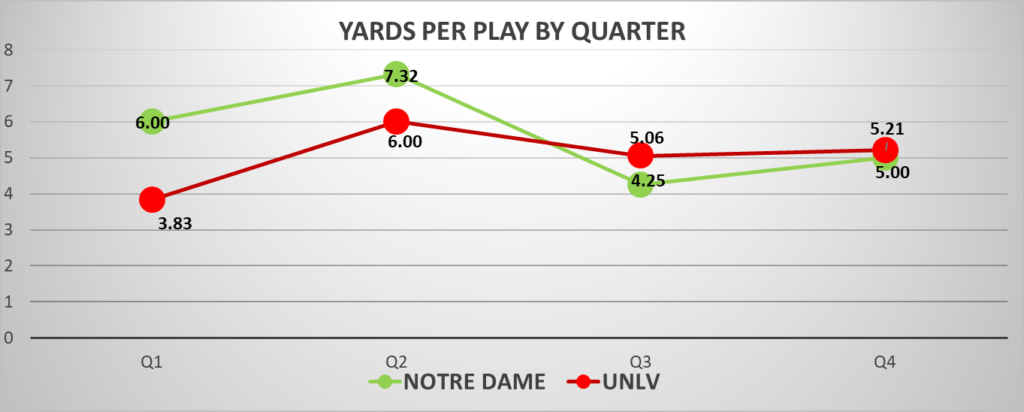
The game could have been well out of hand by halftime – while the ND defense melted to allow an early 74-yard run that led to a Rebel touchdown, the next 17 UNLV plays went for a total of -5 yards. Lack of explosive plays on offense paired with a defensive penchant for lapses also helps keep a game like this closer than necessary – in a game Notre Dame dominated down-to-down (+22% in success rate), they only outgained the Rebels by 0.9 yards per play.
If you’re interested in more thoughts on the game and the season, I joined the always-excellent Rakes Report this week to talk about the gameday experience this weekend and latest big-picture thoughts on Marcus Freeman’s freshman year.
This game is in the grey zone of garbage time – SP+ defines it as a games with a lead of 23+ in the 4th quarter. By that definition, this game was in and out at various points, and the Irish did stop throwing the ball down the stretch. But the starters were still unfortunately in, and I err on the side of including plays, so have included all plays except kneel-downs in the breakdown below.
Stats from a few excellent sources – College Football Data, Game On Paper, and often referencing SP+ and FEI numbers. If you get lost, check out this handy advanced stats glossary here or reach out in the comments.
A missed opportunity for the offense to run wild
Notre Dame’s surface-level numbers in this game were just fine – 44 points, creating scoring chances on 11 of 14 possessions, with seven red zone trips. But considering the opponent it was a laborious effort, and failed to take advantage of insanely good field position provided by the Irish defense and special teams. The offense gained around 30 yards per possession, far closer to the performance against Marshall (29 yards / possession) than UNC (58) or BYU (50).
It was an off game for Drew Pyne, who finished with 7.3 yards per attempt boosted by a few pop passes and with below-average efficiency. The struggles on passing downs returned, as after the long completion to Jaden Thomas on the game’s first drive Pyne was 0-7 (1 catch, 1 interception, 5 incompletions) converting 3rd and 5+.
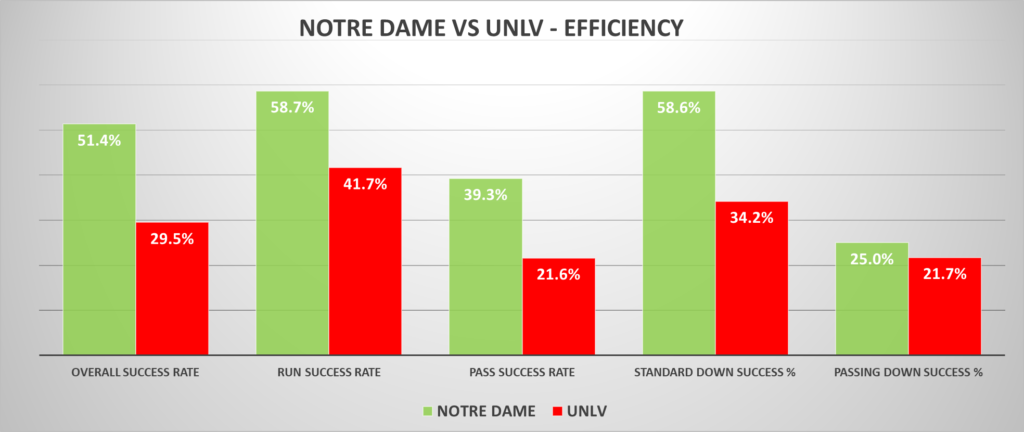
Michael Mayer was again a major focal point in a way that was too predictable. The star tight end saw 12 of Pyne’s 28 target go his direction. These were good for 9.58 yards per target, which is great! But those targets were far more productive when the Rebel defense was less certain what was coming their way:
- Early down targets (7): 15.8 yards / target, 71% successful, 5/7 targets caught
- 3rd/4th down targets (5): 0.8 yards / target, 0% successful, 1/5 targets caught
The offense has to set up better options on passing downs (using Mayer as decoy sometimes feels like it’d be very effective) and tap into additional receiving targets. Of the 16 targets that didn’t go to Mayer, only six were successful plays, with just one play of more than 20 yards. The combination of Pyne’s limitations, Rees’s gameplan, and the wide receivers is allowing opposing defenses to have very little fear of getting beat deep for explosive plays.
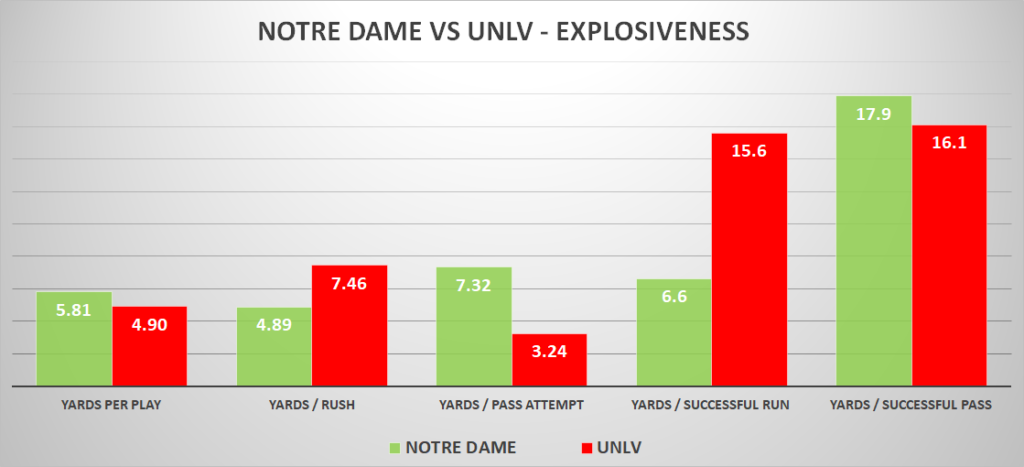
Speaking of explosiveness, the Irish rushing game also struggled to get loose. The long rush of the day belonged to Drew Pyne, and while Logan Diggs had a nice stat line (28 carries for 130 yards) it was very much a “grind-it-out” effort. Only 5 of 41 carries by the running backs went for double-digit yards. The Audric Estime fumbling issues (and subsequent benching against UNLV) are unfortunate, as with a pretty even split of carries among the three backs he has both the lowest stuff rate and highest explosive run rate.
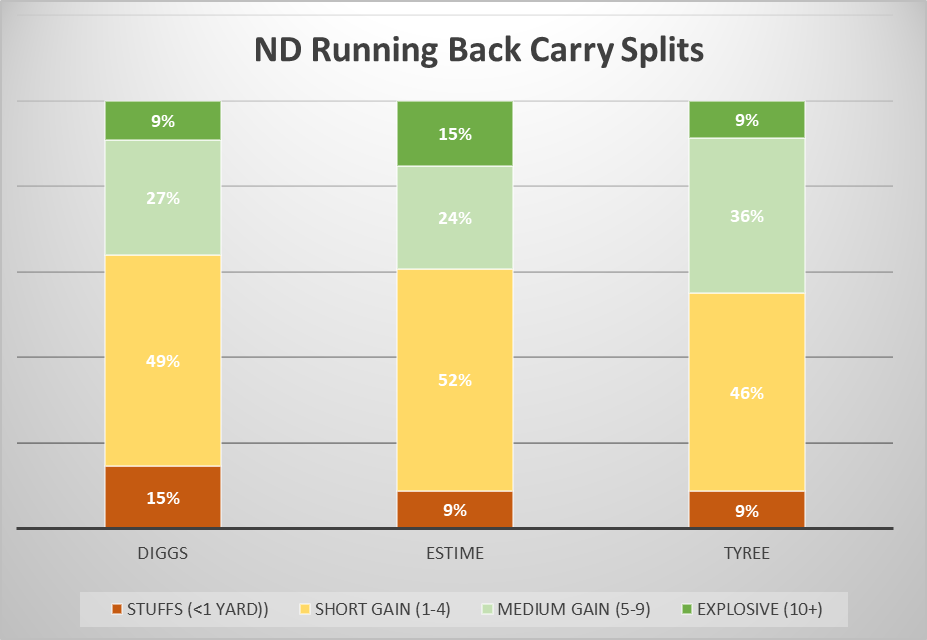
The passing and rushing attacks continue to impact one another, and without much play-action or downfield passing threat defenses are free to key on the running game and Mayer. An opponent like Syracuse, which has struggled against the run but been very good in pass coverage, shouldn’t have much fear about prioritizing run defense. Pyne will need to perform well and Tommy will need to mix it up enough with perimeter passing attacks and misdirection to keep things manageable on the ground, and just maybe create some explosive runs.
Havoc arrives, now needs to translate
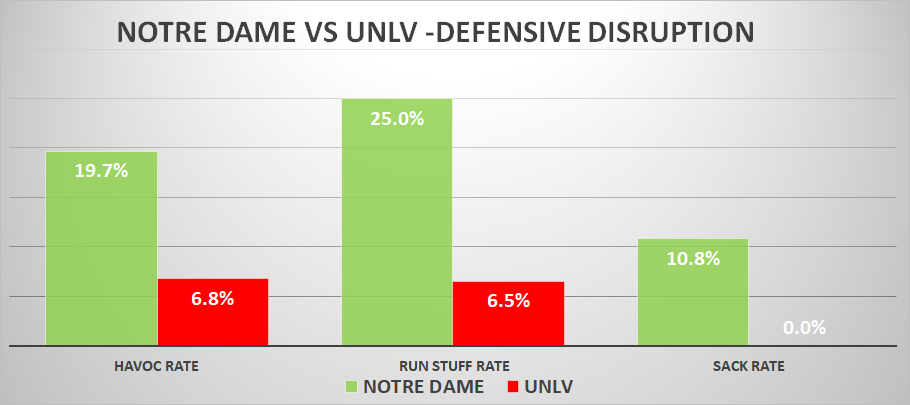
Last week friend of the review Jamie Uyeyama wrote about how Al Golden needed to mix things up to challenge opposing offensive lines. It’s only UNLV, but Isaiah Foskey and company dominated for long stretches both on defense and in special teams. The only major flaw was the explosive play bugaboo did pop up a couple of times in run defense.
For all the negativity about the offense above, the Irish offense does continue to limit opponent disruption and keep things manageable for Pyne and company. After not allowing a single TFL and sacks against UNLV, Notre Dame is now 21st in FBS in havoc allowed after a rough start. There are likely trade-offs in explosiveness with this approach, but the average 3rd down distance for the Irish to gain against the Rebels was four yards, keeping Pyne out of unfavorable situations.
Notre Dame continues bleeding points with scoring opportunities
The Irish averaged exactly four points per scoring opportunity (defined as a first down inside the opponent 40) against UNLV. It wasn’t the worst output of the year, but since this has been a season-long struggle you’d love to see some of these issues getting worked out. Instead Notre Dame settled for four field goal attempts and had three empty trips between one Grupe miss, the Pyne interception, and a failed fourth down attempt.
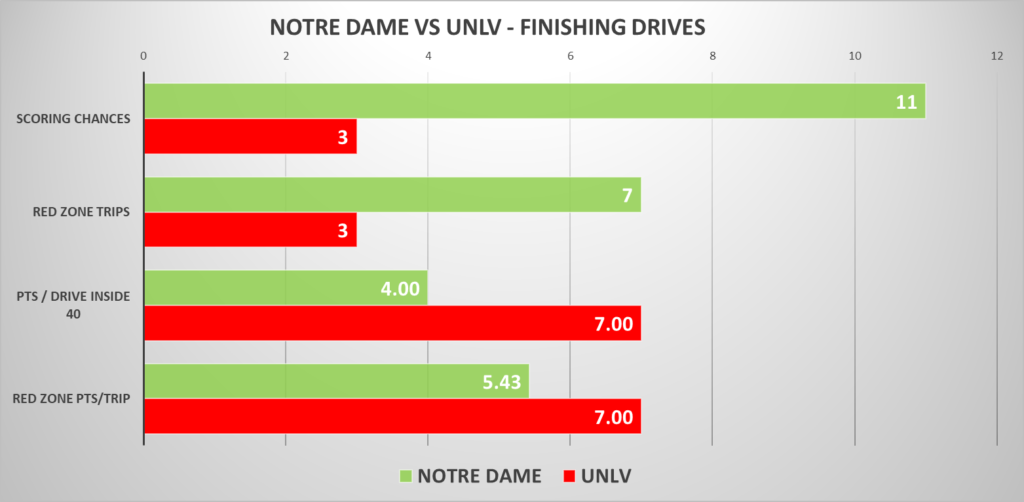
For the season ND now ranks 89th in points per scoring chance (3.64 points per opportunity). It’s not shocking for an offense that struggles with consistency, but is a major problem for a team that hopes to have some chance at three upsets in the final five games.
The defensive performance limiting opponents in these situations is not better. The Irish are dead last in FBS in red zone defense, allowing scores on 100% of opponent trips and touchdowns on 82% of them (130th, besting only Rutgers). Allowing 4.47 points per opponent scoring chance is 121st. It’s pretty incredible that Notre Dame is still 27th in points per drive allowed despite being this bad allowing opponents to convert. If there’s good news, there almost has to be regression to the mean on both sides of the ball?
On to Syracuse
This may seem like an overly negative review for a game that was never really in doubt, but it feels like a missed opportunity. It was a chance for Drew Pyne and Tommy Rees to get cooking again, to build up the connection with the wide receivers, or for the offensive line to dominate and maybe run for 300 yards. Before the season it’s probably a game the staff also had earmarked to get young guys and backups reps in, which never materialized. The defense at least could check a few boxes, increasing the disruption and forcing another turnover, which hopefully will build some confidence leading into a tough final stretch.
It also feels like for the hardcore fans we’re now heavy into over-analysis season. What does this mean for Marcus Freeman, or Tommy Rees? Was Al Golden a swing and miss at DC? What will change with the offense next year? It’s still so so early for these questions beyond entertainment purposes (which believe me, I am still here for, just as long as we hold hands and acknowledge how little we know). The very inconsistent and middle-of-the-road performance this season may not be much more complicated than stretches of bad QB play, in part due to injury, known roster gaps at spots like wide receiver coming to life with a vengeance, and defense that’s solid but not good enough to dominate and win you games on its own (like Stanford).
From the outside, it does feel like Notre Dame is a program badly in need of a momentum win down the stretch. Whether it’s “away from Notre Dame Stadium” Pyne reappearing in the Carrier Dome or the coaching staff finding some gameplan magic, a win against an overachieving but very solid Orange squad would be a godsend. For as frustrating as its been to watch Notre Dame play down the level of their competition for much of the season, maybe Freeman can help the Irish conjure up the strong early start playing up to Ohio State’s level and this time pull it off down the stretch.





Really feels like the ND defense is the opposite of bend-but-dont-break. If you can get a drive going, it feels like a guarantee you’re going to score, and it’s probably gonna be a TD
I wish we could build a franken-DC by combining Freeman’s recruiting abilities with Lea’s gameplans and adjustments.
I’d settle for just actual Freeman as DC. Really wish we just had last year’s staff +Stuckey.
I’m secretly hoping Vandy fires him soon so we can get him back.